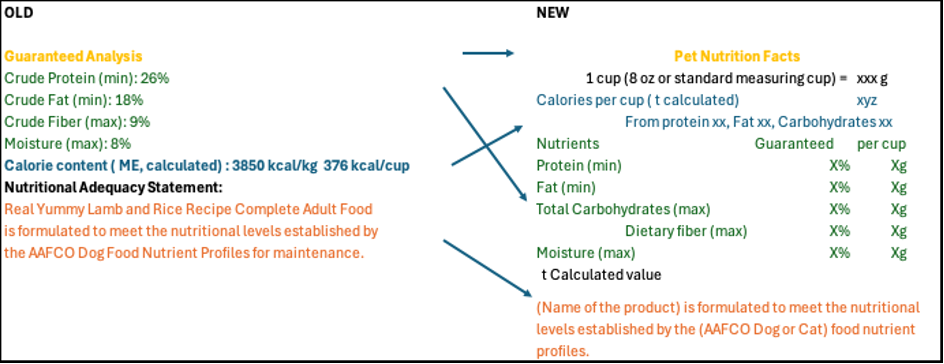What drives the new cat food label changes?
Cat food labels are confusing and difficult to read. A 2015 survey conducted and presented by many pet parents agreed with this statement (1). This survey initiated the Pet Food Label Modernization Act (2), which resulted in a long-anticipated change in pet food labeling guidelines within the next five years.
Pet parents want pet food labels to look like human food labels, including the “Nutrition Fact Box.” This would help prevent cat obesity and avoid overfeeding. The 2015 survey is behind Congress's request to the FDA to simplify pet food labels. The FDA involved AAFCO, and now, in 2025, PFI is spearheading a bill that will lead to more consumer-friendly pet food labels within the next five years.
The survey asked for consumer input and what type of changes would benefit them. Consumers want more transparency and easier-to-read labels.
These are the key initiatives stemming from this survey:
- A “Nutrition Fact Box” like it can be found in every food product.
- The intended use of the product must be on the lower third part of the front panel.
- The harmonized verbiage for supplementary food products is “mixer”.
- A standardized set of icons to display storage and handling instructions.
- Common names for vitamins.
- Use of a common household unit for measurements.
The timeline for all manufacturers started in February 2024. The implementation period will be 6 years. The six-year implementation period is taking product- and label inventory into consideration. We will see many companies adopt the new label rules much earlier. This project has been in the making for a long time. And many companies choose to adopt early. Early adoption means to fulfill the consumer’s request for more transparency and simplicity. The early bird will catch the worm, so they say!
If a company chooses to move faster than state regulators, we will see a mix of pet food labels on the shelves of retailers. Retailers will need to be educated about the changes so they can pass on this information to cat parents.
This is a comparison of how new pet food labels will look like.
What are the benefits of the new label format?
Easier to read and understand.
US Pet owners are used to this type of label for human food products.
Calories are displayed per common household unit.
More accurate nutrition information.
How many calories are from protein, fat, and carbohydrates?
Amount of fiber in the carbohydrate portion.
Standardized information
Standardized verbiage if the product is a complete food or a mixer.
Harmonized product storage and handling information.
For now, here are a couple of tips and tricks that help you determine if the cat food you are purchasing is complete and balanced, high in moisture, or a topper that should not be fed solely:
1. Look for the nutritional adequacy statement.
These are examples of the three formats used by manufacturers:
Option 1:
“___________ is formulated to meet the nutritional levels established by the AAFCO Dog (or cat) Food Nutrient Profiles for ___________.”
Option 2:
“Animal feeding tests using AAFCO procedures substantiate that ______________ provides complete and balanced nutrition for _____________.”
Option 3:
“_____________ provides complete and balanced nutrition for ___________ and is comparable to a product which has been substantiated using AAFCO feeding tests”
If you do not see one of the three statements on the label the product can not be fed as the sole source of food to an animal.
2. Compare the moisture content in wet food products.
Wet cat food can have a maximum moisture content of 78%. If it has more than 78%, it must be labeled as an “in juice, stew, gravy, consommé or broth” product.
Humans may consider a label that reads “chicken in consommé” of higher value compared to just “chicken”. But be aware, in pet food language it means more water (and probably gels and thickeners) have been added to the product and it is of lower caloric density.
3. Check caloric density and feeding guidelines.
Manufacturers are required to display the caloric density of the food. Take a close look, compare products, and see how much you would need to feed your cat to meet the caloric needs per day.
A wet cat food product A with a caloric density of 60kcal/3oz can is a very different proposition compared to a wet cat food product B with a caloric density of 100kcal/3oz can.
If your adult healthy cat weighs 11lbs and needs roughly 300 kcal per day you would need to feed 3 cans of the food B. But 5 cans of food A. Calculating the daily feeding cost based on caloric density of a food is the correct way to do it. Many people only compare the cost of product A in a 3oz can versus product B in a 3oz can.
Moving forward, pet food buyers will be able to look at the nutrition fact box of two products and compare easily how many calories are in one serving and where the calories come from.
(1) (https://www.ngfa.org/wp-content/uploads/Barritt-breakout-Consumer-Confusion-on-Pet-Food-Labels.pdf
(2) (https://www.aafco.org/pflm/)

